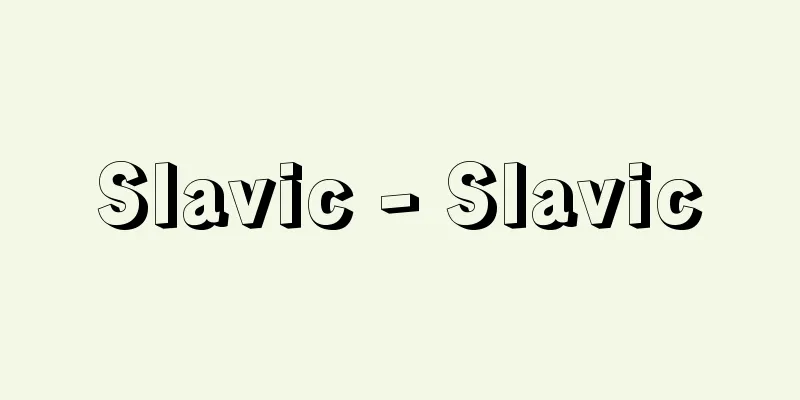Slavic - Slavic

|
It is a major language group belonging to the Eastern group (so-called "Satemic group") of the Indo-European language family, which originates from a single Proto-Slavic language and has now branched into a dozen or so languages. It is divided into three subgroups based on its development history and degree of relatedness. (1) East Slavic languages: (1) Russian, (2) Ukrainian, (3) White Russian (Belarusian). (2) West Slavic languages: (1) Polish, (2) Kashubian (spoken in the left bank of the lower Vistula River in Poland), (3) Slobind (spoken in the northwestern part of the Kashubian region, but now extinct), (4) Polabian (spoken in the left bank of the lower Elbe River, but became extinct in the mid-18th century), (5) Upper Sorbian (spoken in the upper Spree River basin in eastern Germany, also known as High Lausatian), (6) Lower Sorbian (spoken in the northern part of (5), also known as Low Lausatian), (7) Czech, and (8) Slovak. (3) South Slavic languages: (1) Bulgarian, (2) Serbo-Croatian, (3) Slovenian, and (4) Macedonian. Slavic languages are unique among the Indo-European languages in that they have generally maintained a close kinship with each other and have relatively well preserved the archaic grammatical structures of Indo-European languages. Proto-Slavic originated as a dialect of Proto-Indo-European, which gradually developed between 2000 BC and 1500 BC and remained unified for about 3000 years until its final disintegration into dialects around 1000 AD. Individual Slavic languages began to form around the beginning of the 1st century AD, and many of them are about 2000 years old. The remarkable kinship between the Slavic languages can be explained by the fact that the common proto-language is longer in history than the individual languages themselves. The Slavic family is most closely related to the neighboring Baltic family. Regarding the deep affinity between the two languages, there are two competing theories: the theory of a common origin, which assumes a common Balto-Slavic proto-language, and the theory of parallel development, which posits that the similarities between the two languages are the result of long-term mutual contact and influence. This debate continues to this day. After the Christian era, the Slavic languages came into contact with Germanic, Indo-Iranian, non-Indo-European Finno-Ugric, and Altaic languages, and these influences are reflected in the vocabulary of Proto-Slavic. Proto-Slavic itself is a hypothetical proto-form and cannot be documented, but Old Church Slavic, found in manuscripts of church documents from the 10th and 11th centuries, conveys the most primitive structure and form of Slavic, and is considered an essential resource for the history and comparative linguistics of Indo-European and Slavic languages. While Proto-Slavic has a typical Indo-European character, it also has unique features not seen in other Indo-European languages. The main points are as follows. In terms of phonology, two phenomena stand out: (1) there is a consistent and systematic opposition between front vowels (soft vowels) and back vowels (hard vowels), and (2) it has the "open syllable rule" which removes consonants at the end of syllables and ends syllables with vowels, disliking closed syllables of Proto-Indo-European origin. The opposition between the two series of hard and soft vowels had a decisive influence on the fate of the velar consonants g, k, and x, which underwent two types of changes immediately before the front vowel: "primary palatalization" (g, k, x > ž, č, š) and "secondary palatalization" (g, k, x > dz, c, s). The appearance of the nasal vowel ę can also be explained by the open syllable rule. Grammatically, Slavic languages retain archaic features that other Indo-European languages have lost, and have a comprehensive language structure rich in inflections. Nouns have only lost the ablative case, but retain the old case forms and functions of nominative, genitive, dative, accusative, instrumental, locative, and vocative. In terms of gender, in addition to masculine, feminine, and neuter, Slavic languages now have a distinction between animate and inanimate, and in terms of number, in addition to singular and plural, Slavic languages have dual forms. In terms of verb system, the person declension of the present tense is closest to the Proto-Indo-European form, but the other declensions such as tense, mood, and participle are new developments. The greatest feature of Slavic verb system is the development of the aspect category, which is essentially a two-series oppositional correlation between the perfect tense, which indicates the completion of the process of an action, and the imperfect tense, which does not have this characteristic. [Kurihara Shigeru] [References] | |Source: Shogakukan Encyclopedia Nipponica About Encyclopedia Nipponica Information | Legend |
|
インド・ヨーロッパ(印欧)語族の東方群(いわゆる「サテム語群」)に属する有力語派で、単一のスラブ祖語に遡源(そげん)し、現在十数個の諸言語に分岐している。発達史と近親性の度合いに基づいて三つの下位語群に分類される。 (1)東スラブ語群 〔1〕ロシア語、〔2〕ウクライナ語、〔3〕白(はく)ロシア語(ベラルーシ語)。 (2)西スラブ語群 〔1〕ポーランド語、〔2〕カシューブ語(ポーランドのビスワ川下流左岸地方で話される)、〔3〕スロビンツ語(カシューブ語領域の北西部で話されたが、現在は死語)、〔4〕ポラーブ語(エルベ川下流左岸地方で話されたが、18世紀なかばに死滅)、〔5〕上(かみ)ソルブ語(ドイツ東部のシュプレー川上流域で話され、高地ラウジッツ語ともいう)、〔6〕下(しも)ソルブ語(〔5〕の北部で話され、別名低地ラウジッツ語)、〔7〕チェック語(チェコ語)、〔8〕スロバキア語。 (3)南スラブ語群 〔1〕ブルガリア語、〔2〕セルビア・クロアチア語、〔3〕スロベニア語、〔4〕マケドニア語。 スラブ諸語は、概して、緊密な近親関係を崩さず、印欧語の古風な文法構造を比較的よく保持している点で、印欧語族のなかでも希有(けう)な語派である。スラブ祖語は起源的には印欧祖語の一方言であり、紀元前2000年から前1500年にかけて漸次形成され、紀元後1000年ごろまで、最終的に方言分裂して崩壊するまでの約3000年間統一を保っていたと考えられる。個々のスラブ語は紀元1世紀が始まるころ形成され始め、それらの多くは約2000年の歴史をもつ。スラブ諸語間の著しい近親性は、共通祖語の時代が個々の言語の歴史よりも長いという状況から説明しうる。スラブ語派は隣接のバルト語派ともっとも密接な親族関係にたつ。両語派の深い近親性については、バルト・スラブ共通祖語を想定する同一起源説と、両者の類似性を長い間の相互接触、影響によるものとする並行発達説とが有力学説として対立し、今日なお論争が続いている。スラブ語派は紀元後はゲルマン語派、インド・イラン語派、非印欧語系のフィン・ウゴル語族、アルタイ語族と接触し、その影響はスラブ祖語の語彙(ごい)構成に反映されている。スラブ祖語そのものは仮説上の祖形であって文証しえないが、スラブ語のもっとも原初的な構造と形態を伝えているものに、10~11世紀の教会文書の写本にみられる古代教会スラブ語があり、印欧語およびスラブ語の歴史、比較言語学の不可欠の資料とされている。 スラブ祖語は典型的な印欧語的性格をもちながら、一方では、他の印欧語にみられない独特の特徴をもつ。その主要な点をあげる。音韻面では、〔1〕前舌母音(軟母音)と後舌母音(硬母音)とが一貫して体系的に対立する、〔2〕印欧祖語起源の閉音節を嫌って音節末の子音を除去し、音節を母音で終わらせる「開音節の法則」をもつ、という二つの現象がとくに目にたつ。母音の硬軟二系列の対立は軟口蓋(なんこうがい)子音g,k,xの運命に決定的な影響を及ぼし、それらは前舌母音の直前の位置で「第一次口蓋化」(g,k,x>ž,č,š)と「第二次口蓋化」(g,k,x>dz,c,s)の二通りの変化を受けた。鼻母音ę,の出現も開音節の法則によって説明できる。文法面では、他の印欧語が喪失した古風な特徴を保持し、屈折辞に富んだ総合的言語の構造をもつ。名詞類は奪格を失ったのみで、主格、属格、与格、対格、造格、所格、呼格の古い格の形態と機能を保ち、性においては男性、女性、中性のほかに活動体と不活動体の区別をもつようになり、数においては単数、複数のほかに双数の形態をもつ。動詞組織においては現在時制の人称変化がもっとも印欧祖語の形に近いが、他の時制、法、分詞などの変化形態は新しい発達形である。スラブ語の動詞組織の最大の特色は、動作の過程の完結性を表す完了体と、その特徴表示をもたない不完了体の二系列の対立相関を本質とするアスペクト(相)のカテゴリーの発達である。 [栗原成郎] [参照項目] | |出典 小学館 日本大百科全書(ニッポニカ)日本大百科全書(ニッポニカ)について 情報 | 凡例 |
<<: Slavs - Slavs (English spelling)
Recommend
Indo-Germanisch (English spelling)
…In ancient times, the name Aryan was also used, ...
catechumenal school
... After the decree of Emperor Theodosius in 392...
The world of writing
A literary magazine. From March 1906 (Meiji 39) t...
Epidendrum cochleatum - Epidendrum cochleatum
…It is widely distributed in Latin American count...
Osahito -
…The fourth son of Emperor Ninko. His name was Os...
North West Company
Also known as the Northwest Fur Company. A fur tra...
Nittaiji Temple
A temple located in Houou-cho, Chikusa-ku, Nagoya...
Extreme ultraviolet region
...When the wavelength is below 100 nm, thin meta...
Visby (English spelling)
The capital of Gotland County in southeastern Swed...
Nearchos - Nearchos (English spelling)
He was one of Alexander the Great's most trus...
Nation (English spelling)
In French, it means a nation, a nation, or a state...
Door -
[1] 〘 noun 〙① to. door. [Book of Changes - Jici, V...
MIS (Business Management Information System)
...an information system established within an or...
Cissus javana (English spelling) Cissusjavana
… [Mitsuru Hotta]... *Some of the terminology tha...
Icon Veneration
… The Second Council of Nicaea was the seventh ec...









